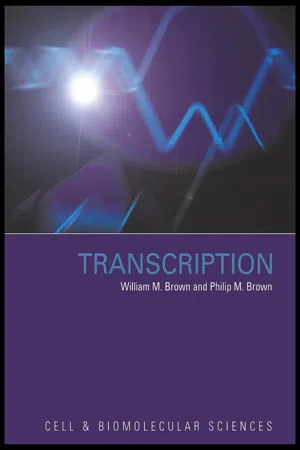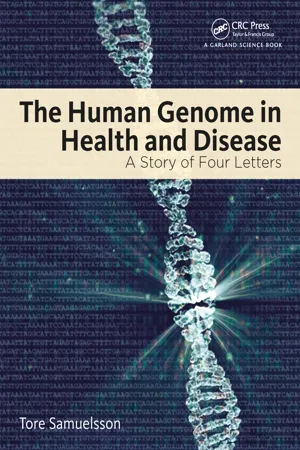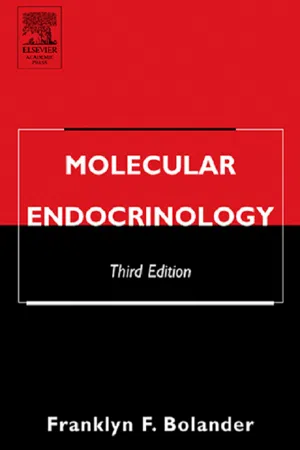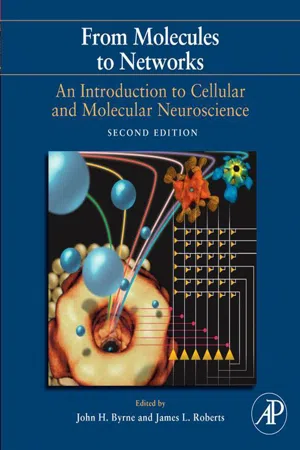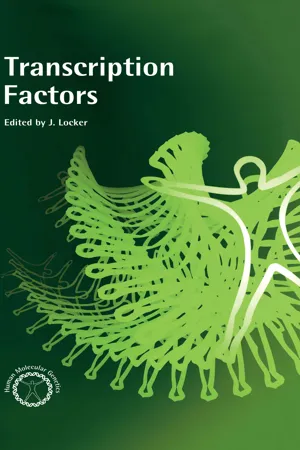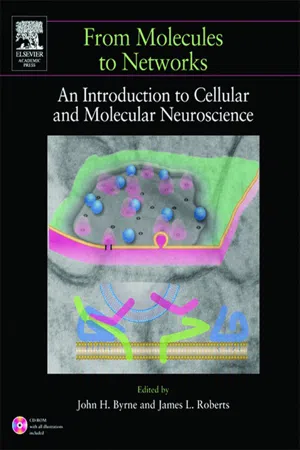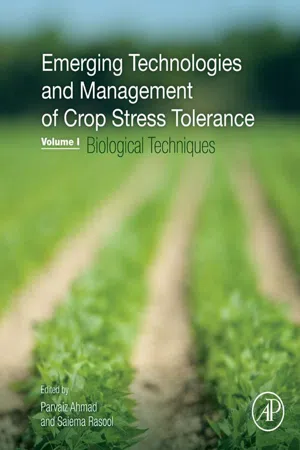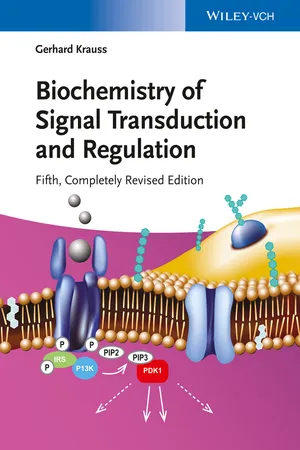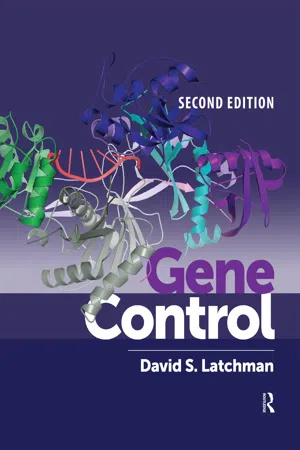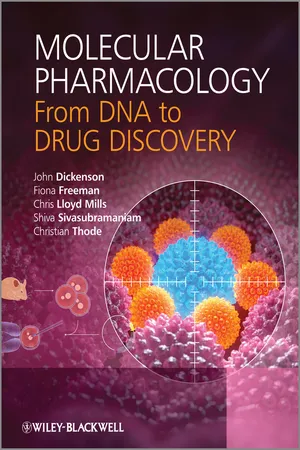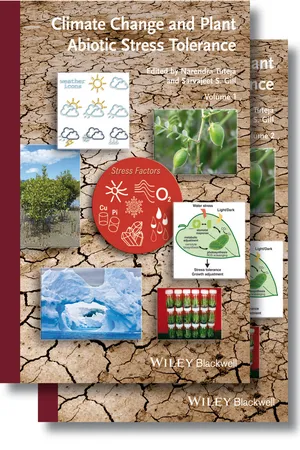Biological Sciences
Transcription Factors
Transcription factors are proteins that regulate the transcription of specific genes by binding to DNA. They play a crucial role in controlling gene expression and are involved in various cellular processes such as growth, development, and response to environmental stimuli. By binding to specific DNA sequences, transcription factors can either activate or repress the transcription of target genes, thereby influencing the production of specific proteins.
Written by Perlego with AI-assistance
Related key terms
12 Key excerpts on "Transcription Factors"
- eBook - ePub
- William M. Brown, Philip M. Brown(Authors)
- 2001(Publication Date)
- CRC Press(Publisher)
cis-regulatory elements of target genes and are regulators of gene transcription. There are two classes of Transcription Factors regulating transcription in eukaryotes: general Transcription Factors—components of the basal transcriptional machinery, which will be discussed in the next chapter—and sequence- and tissue-specific Transcription Factors.At a gross level, Transcription Factors can be regulated at two levels, concentration (amount) and activity. As a general matter, the concentration or amount of a transcription factor in a cell can be regulated at several levels: transcription, RNA processing, mRNA degradation, and translation.Additionally, the activity of some Transcription Factors is altered by ligand binding, as is seen in the steroid hormone receptor superfamily. This will be further discussed below.During evolution, several ways of regulating the activity of Transcription Factors and proteins in general have developed, including phosphorylation, acetylation, nuclear localisation, DNA binding, and trans-activation. DNA-binding activity of Transcription Factors can be regulated by phosphorylation (e.g., heat shock factor and serum response factor) or dephosphorylation (e.g., PKC-dependent threonine dephosphorylation of c-Jun). Other mechanisms include O-glycosylation of—for example—the transcription factor Spl. Spl is a ubiquitously expressed transcription factor that is particularly important in the regulation of TATA-less genes that encode housekeeping proteins. Perhaps surprisingly for intracellular proteins, glycosylation is common in Transcription Factors that operate with RNA polymerase II. The exact functional role of the glycosylation of Spl remains to be determined.These and other mechanisms allow Transcription Factors to effect the controlled expression of specific subsets of the genome in different cells at different times in response to different signals. Additionally, when analysing this issue, it should be remembered that a protein can very much affect transcription without itself actually binding DNA. A protein could act as a bridge between DNA-binding Transcription Factors and the basal transcription machinery, for example. Many Transcription Factors occur in distinct families that share common structural features, especially the DNA-binding domain. Some examples will now be discussed. - eBook - ePub
Cellular Signal Processing
An Introduction to the Molecular Mechanisms of Signal Transduction
- Friedrich Marks, Ursula Klingmüller, Karin Müller-Decker(Authors)
- 2017(Publication Date)
- Garland Science(Publisher)
This enables the cell to modulate the activity of thousands of genes through a relatively small number of Transcription Factors (approximately 6% of the human genome). The factors are organized on the regulatory gene sequences into complex patterns rather than binding side by side. Additional proteins such as co-activators and co-repressors are integrated into this puzzle. These multiprotein complexes are called enhanceosomes. The role of Transcription Factors is either to assemble the initiation complex at a distinct gene locus or to prevent such an assembly. They possess a modular structure typical for signal-transducing proteins that consists of at least three domains: a regulatory domain functioning as a receptor of input signals, a DNA-binding domain for specific interaction with a response element, and a trans(cription)-modulating domain that either activates or deactivates gene transcription (Figure 8.4). Upon activation by the input signal, the transcription factor binds noncovalently to the corresponding response element through an interaction of amino acid residues with complementary nucleotide residues in the major groove of the DNA double helix. By means of their transmodulating (here transactivating) domains, the Transcription Factors that act as inducers now recruit the RNA polymerase complex as well as transcriptional co-activators. These co-activators are proteins that change the chromatin structure in such a way that transcription is facilitated because the RNA polymerase complex can bind to the promoter region and read the gene. Inhibitory Transcription Factors known as repressors have an opposite effect: they recruit proteins called co-repressors that catalyze the formation of an inactive chromatin structure or block the access of the RNA polymerase complex to DNA in another way - eBook - ePub
The Human Genome in Health and Disease
A Story of Four Letters
- Tore Samuelsson(Author)
- 2019(Publication Date)
- Garland Science(Publisher)
The promoter elements discussed so far are those that interact with the basal Transcription Factors, factors that are part of a preinitiation complex and are necessary for the transcription of all genes transcribed by RNA polymerase II. But not all genes are expressed with the same efficiency. Rather, each gene is transcribed at an appropriate level in a specific location in the body and at a suitable point in time, and expression depends on changing requirements. For instance, some genes may be efficiently turned on, while others are completely shut down. This means that each cell type under a certain condition has a characteristic gene expression profile.Critical molecular players in the regulation of transcription are the specific Transcription Factors , proteins that bind to a subset of genes, rather than all of them. These Transcription Factors may act either as repressors or activators of transcription. Each of the proteins will bind to specific regions in DNA. The DNA binding sites may be located within 1,000 nucleotides from the transcription start site, the promoter proximal region. They interact with the general Transcription Factors to influence the formation of the initiation complex.Other essential control elements bound by specific Transcription Factors are the enhancers. These elements are able to stimulate transcription, often at a large distance—several thousand nucleotides—from the actual transcription start site. An enhancer is in the size range of 50–1,500 nucleotides and may be located upstream, downstream, or within the actual gene under control. Enhancers are abundant—it has been estimated that the human genome contains in the order of 400,000 of these regulatory regions. Transcription Factors that bind to enhancers are also able to interact with the transcription initiation complex at the core promoter, thereby causing a loop structure in chromatin (Figure 10.1b ). Both the promoter proximal region of the promoter and enhancers have binding sites for several different Transcription Factors. The mediator, a complex of more than 20 different protein subunits, plays an important role in transcription initiation, transducing signals from the enhancer bound Transcription Factors to the initiation complex that includes RNA polymerase II. The contribution of Transcription Factors to the formation of the transcription initiation complex is summarized in Figure 10.1b - eBook - ePub
- Franklyn F. Bolander(Author)
- 2004(Publication Date)
- Academic Press(Publisher)
Part 4 Gene Regulation by HormonesPassage contains an image
CHAPTER 13 Hormonally Regulated Transcription FactorsFamilies Transcription Activation Domains Chromatin Remodeling IntegrationSpecific Transcription Factors: StructureLeucine Zipper Helix-Loop-Helix and Variations Immunoglobulin-like Family MADS-box Family β-Family Summary of RegulationSpecific Transcription Factors: RegulationProblems Possible SolutionsSpecificityPositive Effects Negative EffectsMechanisms for Transcription EffectsMethodology SequencesHormone Response ElementsSummaryReferencesIn the preceding unit, mechanisms by which hormones and their second messengers directly affect cellular processes were discussed. This unit describes mechanisms by which these molecules affect gene expression. Chapter 13 discusses the hormonal control of specific Transcription Factors and their mechanisms of action. Chapter 14 then examines the role of DNA organization and conformation on transcription; in particular, nucleosomes and their covalent modification, DNA methylation, and DNA conformation are discussed. Finally, the hormonal control of various posttranscriptional events is summarized in Chapter 15 ; such events include RNA stability, processing, transport, and translation, as well as the posttranslational modification of proteins.Specific Transcription Factors: Structure
For completeness, this section will briefly cover each major structural class of specific Transcription Factors. This discussion is then followed by a more detailed examination of those groups that are hormonally regulated. Transcription Factors can be divided into two major groups: specific and general. General Transcription Factors are those proteins responsible for the actual transcription of genes: for example, RNA polymerases, the TATA box binding protein (TBP), and related factors. They are continuously active on housekeeping genes, but induced genes are transcribed only under certain circumstances. The general transcriptional machinery has no intrinsic mechanism to tell when these latter genes need to be expressed. It is the function of the specific Transcription Factors to locate sets of genes that are only expressed intermittently. First, the endocrine system senses the condition and triggers the secretion of hormones that activate specific Transcription Factors; second, these factors then search for specific DNA sequences associated with the various gene sets and recruit the general transcription machinery to them. As such, specific Transcription Factors form a critical link between hormones and gene expression. - eBook - ePub
From Molecules to Networks
An Introduction to Cellular and Molecular Neuroscience
- Ruth Heidelberger, M. Neal Waxham, John H. Byrne, James L. Roberts(Authors)
- 2009(Publication Date)
- Academic Press(Publisher)
Chapter 19 ). Control sequences on DNA determine which segments of DNA can be transcribed into RNA. It is at transcription initiation that extracellular signals such as neurotransmitters, hormones, drugs, and growth factors exert their most significant control. The transcription itself is carried out by RNA polymerases. The transcription is modulated by Transcription Factors that recruit the polymerases to the DNA. For example, the critical nuclear translocation step in the activation of transcription factor CREB involves the catalytic subunit of PKA, which can phosphorylate CREB on entering the nucleus.The genes that encode the Transcription Factors themselves may respond quickly or slowly. These genes have been coined “third messengers” in signal transduction cascades. Cross talk between neurotransmitter and growth factor signaling pathways is likely to play an important role in the precise tuning of neuronal plasticity to diverse environmental stimuli.The active, mature transcription complex is a remarkable architectural assembly of proteins assembled at the basal promoter—in most cases, at a sequence called the TATA box. In addition to RNA polymerase II, this complex includes a large number of associated general Transcription Factors, sequence-specific Transcription Factors, and intervening adapters. A wide variety of Transcription Factors bound to cis -regulatory elements elsewhere in the gene, but permitted to interact by the looping of DNA, join in the formation of the active transcription complex. This remarkable mechanism permits cells to exert exquisite control of the genes being transcribed in a variety of situations, for example, to govern appropriate entry or exit from the cell cycle, to maintain appropriate cellular identity, and to respond appropriately to extracellular signals.Transcription can be regulated by many different extracellular signals modulated by a large array of signaling pathways (many including reversible phosphorylation) and a complex array of Transcription Factors. Most of these factors are members of families and regulate transcription only as multimers. Given this complexity, the potential for very precise regulation is clear, but the mechanisms by which such precision is achieved are not fully understood. In this chapter, regulation has been illustrated by only a few of the families of Transcription Factors. Those chosen appear to play important roles in the nervous system and illustrate many of the basic principles of gene regulation. - eBook - ePub
- Joseph Locker(Author)
- 2003(Publication Date)
- Garland Science(Publisher)
2Regulatory Transcription Factors and ds-regulatory regions
Albert J.Courey1.
Introduction
In eukaryotes, the transcription of protein-encoding genes is directed by two classes of factors, the basal transcriptional apparatus and regulatory factors. The basal apparatus (reviewed in Chapter 1 ) is operationally defined as that set of factors required for accurately initiated basal transcription in a cell-free transcription system. The basal apparatus, which includes pol II and a number of general Transcription Factors, is directed to the 5’ end of a transcription unit by the core promoter. Although core promoters can direct accurate initiation in vitro, they do not generally direct significant levels of transcription in vivo, especially in the context of an intact eukaryotic chromosome. Measurable transcription in vivo generally requires the action of regulatory factors, which interact either directly or indirectly with cis-regulatory elements and modulate the efficiency of transcription from linked core promoters.Regulatory Transcription Factors can be grouped into two broad categories, the sequence-specific regulators and the coregulators (Berk, 1999; Mitchell and Tjian, 1989; Tjian and Maniatis, 1994; Triezenberg, 1995). As their name implies, sequence-specific regulators interact directly with cis-regulatory elements in a sequence-specific manner. In eukaryotic cells, these factors are generally modular in nature. In other words, they consist of independent structural domains that are separately responsible for the various biochemical functions of the factors. Sequence-specific regulators can be further subdivided into activators, which stimulate core promoter utilization, and repressors, which inhibit core promoter utilization. It is not always straightforward to classify a sequence-specific regulator as an activator or a repressor, since many such factors can mediate either activation or repression depending upon the context of their binding sites, or upon the array of interacting ligands available to modulate their conformation and/or activity. In contrast to sequence-specific regulators, coregulators do not interact with DNA directly. Rather, they are directed to regulatory targets by proteinprotein interactions with sequence-specific regulators. Like sequence-specific regulators, coregulators can be further categorized according to whether their role is in gene activation, in which case they are termed coactivators, or in gene repression, in which case they are termed corepressors. - eBook - ePub
From Molecules to Networks
An Introduction to Cellular and Molecular Neuroscience
- John H. Byrne, Ruth Heidelberger, M. Neal Waxham, James L. Roberts(Authors)
- 2003(Publication Date)
- Academic Press(Publisher)
Chapter 18 ). Control sequences on DNA determine which segments of DNA can be transcribed into RNA. It is at transcription initiation that extracellular signals such as neurotransmitters, hormones, drugs, and growth factors exert their most significant control. The transcription itself is carried out by RNA polymerases. The transcription is modulated by Transcription Factors that recruit the polymerases to the DNA. For example, the critical nuclear translocation step in the activation of transcription factor CREB involves the catalytic subunit of PKA, which can phosphorylate CREB on entering the nucleus.The genes that encode the Transcription Factors themselves may respond quickly or slowly. These genes have been coined “third messengers” in signal transduction cascades. Cross-talk between neurotransmitter and growth factor signaling pathways is likely to play an important role in the precise tuning of neuronal plasticity to diverse environmental stimuli.The active, mature transcription complex is a remarkable architectural assembly of proteins assembled at the basal promoter—in most cases, at a sequence called the TATA box. In addition to RNA polymerase II, this complex includes a large number of associated general Transcription Factors, sequence-specific Transcription Factors, and intervening adapters. A wide variety of Transcription Factors bound to cis -regulatory elements elsewhere in the gene, but permitted to interact by the looping of DNA, join in the formation of the active transcription complex. This remarkable mechanism permits cells to exert exquisite control of the genes being transcribed in a variety of situations, for example, to govern appropriate entry or exit from the cell cycle, to maintain appropriate cellular identity, and to respond appropriately to extracellular signals.Transcription can be regulated by many different extracellular signals modulated by a large array of signaling pathways (many including reversible phosphorylation) and a complex array of Transcription Factors. Most of these factors are members of families and regulate transcription only as multimers. Given this complexity, the potential for very precise regulation is clear, but the mechanisms by which such precision is achieved are not fully understood. In this chapter, regulation has been illustrated by only a few of the families of Transcription Factors. Those chosen appear to play important roles in the nervous system and illustrate many of the basic principles of gene regulation. - eBook - ePub
Emerging Technologies and Management of Crop Stress Tolerance
Volume 1-Biological Techniques
- Parvaiz Ahmad, Saiema Rasool(Authors)
- 2014(Publication Date)
- Academic Press(Publisher)
Figure 3.1 ). This transcriptional regulatory system is known as “regulon.”Figure 3.1 Transcriptional regulatory networks. Environmental stress and/or development signals active transcriptional factors. The rectangular boxes named A, B, and C represent the cis -acting factors and circles labeled A, B, and C represent the Transcription Factors. Abbreviations: Ub, ubiquitin; P, phoshorylation.There are numerous regulons involved in plant responses to abiotic stresses. The dehydration-responsive element binding protein 1 (DREB1)/C-repeat binding factor (CBF) regulon plays an important role in plant acclimation to low temperature, whereas the DREB2 regulon is involved in plant response to high temperature and osmotic stress and can modify gene expression independently of abscisic acid (ABA). On the contrary, the ABA-responsive element (ABRE) binding protein (AREB)/ABRE binding factor (ABF) regulon is dependent on ABA and modulates gene expression under osmotic stress. There are also regulons involved in minor pathways, such as NAC (or NAM, no apical meristem) and myeloblastosis–myelocytomatosis (MYB/MYC), that control ABA and jasmonic acid (JA)-inducible gene expression under cold and osmotic stresses (Saibo et al., 2009 ; Todaka et al., 2012 ; Yamasaki et al., 2012 ) (Figure 3.2 ).Figure 3.2 Transcriptional network of abiotic stress responses. Transcription Factors are shown in ovals. Transcription factor-modifying enzymes are shown in circles. The small triangles correspond to post-translational modifications. Sky-blue squares with question marks represent putative MYC ICE1-like Transcription Factors that may activate CBF1/DREB1B and CBF2/DREB1C. The sky-blue boxes represent the cis -elements present in stress-responsive genes. The red dot corresponds to the sumoylation modification by SIZ1 of the ICE1 transcription factor. The dashed black line from SIZ1 to HOS1 represents competition for binding sites on the ICE1 transcription factor. SIZ1 blocks the access of HOS1 to the ubiquitination sites on the ICE1.Adapted from Woodrow et al., 2012b - Gerhard Krauss(Author)
- 2014(Publication Date)
- Wiley-VCH(Publisher)
It is estimated that yeast contains about 300 Transcription Factors, whereas the human genome encodes about 2600 proteins that harbor DNA-binding domains of which a large proportion is thought to bind sequence-specifically to DNA elements. A typical transcription factor is of modular structure (Figure 4.10), and binds as a dimer or higher oligomer to the RE. A DNA-binding domain, one or more activation or repression domains, as well as dimerization domains and regulatory domains, are characteristic structural elements of sequence-specific Transcription Factors in eukaryotes. Sequence-specific Transcription Factors: Bind to cis-elements Register signals Transmit signals to RNA Pol, Mediator, and chromatin. Figure 4.10 Typical domains of transcriptional activators. The sequential order of the domains is variable. Aside from their DNA-binding property, Transcription Factors have the ability to register regulatory signals and to transmit these on to the transcription apparatus and chromatin. Modular structure of Transcription Factors: DNA-binding domain Dimerization domain Transactivating domain Regulatory domain. The various domains of Transcription Factors do not function in isolation, as suggested from the linear representation in Figure 4.10. Rather, structural analyses of intact eukaryotic Transcription Factors have shown that the domains are tightly packed and are conformationally and functionally coupled. It is now well established that eukaryotic Transcription Factors are allosteric proteins that exist in different conformations and thereby may perform distinct functions. The various conformations are in equilibrium, and this equilibrium may be shifted by regulatory influences such as binding to the RE, PTM (e.g., phosphorylation), and the binding of cofactors and of chromatin-remodeling proteins. The nature of these influences specifies a distinct population of conformations and thereby a distinct function- eBook - ePub
- David Latchman(Author)
- 2020(Publication Date)
- Garland Science(Publisher)
5.16 ). As discussed in the next two sections, the recruitment of co-activators and co-repressors by DNA-bound transcriptional activators or repressors, respectively, plays a critical role in transcriptional activation or repression. Thus, differences in the factors recruited by a factor bound to different DNA sequences will play a significant role in determining its effect on the transcription of its target genes.5.2 Activation of Transcription
Although binding of Transcription Factors to DNA is generally a necessary prerequisite for the activation of transcription, it is clearly not in itself sufficient for this to occur. Following binding, the bound transcription factor must somehow regulate transcription, for example, by directly activating the RNA polymerase itself or by facilitating the binding of other Transcription Factors and the assembly of a stable transcriptional complex or by recruiting chromatin remodeling complexes.Activation domains can be identified by “domain-swap” experiments
It is clear from Section 5.1 of this chapter that Transcription Factors have a modular structure in which a particular region of the protein mediates DNA binding, while another may mediate binding of a co-factor such as a hormone, and so on. It seems likely, therefore, that a specific region of each individual transcription factor will be involved in its ability to up-regulate transcription following DNA binding.In the majority of cases, it is clear that such activation regions are distinct from those that produce DNA binding. This domain-type structure is seen clearly in the yeast transcription factor GCN4, which mediates the induction of the genes encoding the enzymes of amino acid biosynthesis in response to amino acid starvation. If a 60 amino acid region of this protein containing the DNA-binding domain is introduced into cells, it can bind to the DNA of GCN4-responsive genes but fails to activate transcription. Although DNA binding is necessary for transcriptional activation to occur, it is not therefore sufficient, and gene activation must be dependent upon a region of the protein that is distinct from that mediating its binding to DNA. - eBook - ePub
Molecular Pharmacology
From DNA to Drug Discovery
- John Dickenson, Fiona Freeman, Chris Lloyd Mills, Christian Thode, Shiva Sivasubramaniam(Authors)
- 2012(Publication Date)
- Wiley(Publisher)
Drugs that target specific moieties on Transcription Factors such as phosphorylation sites, nuclear localisation domains, DNA binding sites, or co-activator(s) interaction sites have been developed for the treatment of tumourgenesis. However, this approach can lead to the development of drugs that target regions that could be conserved in other proteins. So unless compartment specific therapies can be developed the side effects of these drugs would be unacceptable. This has led researchers to develop strategies that determine which genes are regulated by these ‘transcription factor-mediating’ drugs. Employment of reporter gene assays (e.g. green fluorescent protein; GFP) would create large libraries that can be analysed to determine which transcription factor(s) are affected by these drugs. This would allow the development of transcription factor specific agonists and antagonists. In fact this approach has led to development of an inhibitor of a transcription factor STAT1 (signal transducer and activator of transcription 1); 2-(1,8-naphthyridin-2-yl)phenol (2-NP). This transcription factor is implicated in cancer formation and 2-NP has been shown to reduce proliferation in breast cancer studies (Lynch et al., 2007). Nifuroxazide is another anti-cancer drug that has been shown to be a potent inhibitor of the transcription factor, STAT3 function as well as possessing anti-proliferation activity (Nelson et al., 2008).8.4 Nuclear receptors
Nuclear receptors (NR) are Transcription Factors that can facilitate or repress gene expression. Ligands or metabolic factors can enter the cell and either activate NRs in the cytoplasm so that they enter the nucleus or activate nuclear located NRs. Once activated the NR can alter gene expression as monomers, homodimers or as heterodimers with, for example, the retinoic acid receptor (RAR). There is considerable debate in the literature as to how NRs evolved. The current view is that they evolved from environmental sensors where extracellular factors enter the cell enabling the cell to adapt to changing environments. This theory is compelling because in animals NRs play an important role in homeostasis, development and growth. In addition, NRs can be activated by ligand binding or their activity can be modulated by the activity of signalling pathways within the cell. - Narendra Tuteja, Sarvajeet S. Gill, Narendra Tuteja, Sarvajeet S. Gill(Authors)
- 2013(Publication Date)
- Wiley-Blackwell(Publisher)
Within the Arabidopsis thaliana genome, 32 families of genes have been identified as encoding Transcription Factors that contain three or more members [7]. Each family is characterized by a unique region of highly conserved amino acid sequence, which usually comprises the DNA-binding domain. Plants devote a large portion of their genome capacity to Transcription Factors, with the Arabidopsis genome coding in excess of 1500 Transcription Factors, which represents over 5% of the total genes [7,8]. Various transcriptional regulatory mechanisms function in the abiotic stress signal pathways [9,10]. Both ABA-dependent and ABA-independent signal transduction pathways from stress signal perception to gene expression involve different Transcription Factors. Some Transcription Factors follow an ABA-dependent signal transduction pathway, while others appear ABA-independent. The ABFs (ABRE-binding factors)/AREBs (ABA-responsive element-binding proteins), MYC/MYB, DREB2 (dehydration-responsive element binding) and NAC (NAM, ATAF, and CUC) Transcription Factors are involved in ABA-dependent and ABA-independent gene expression pathways under dehydration and salt stress, whereas CBF (CRT-binding factor)/DREB1 involved in cold stress-responsive gene expression through thee ABA-independent pathway [4]. These major stress-responsive transcription factor regulates different genes under different stress conditions, and overexpression of these Transcription Factors upregulates many genes that are involved in stress response and tolerance [4]
Index pages curate the most relevant extracts from our library of academic textbooks. They’ve been created using an in-house natural language model (NLM), each adding context and meaning to key research topics.
